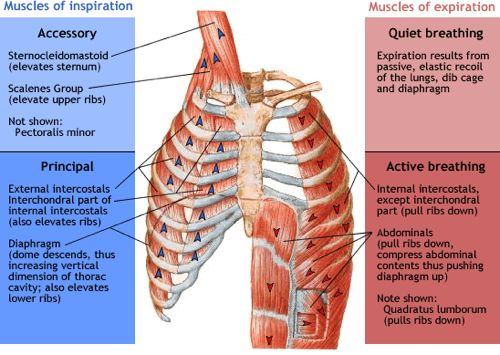Muscles of Respiration
Original Editors - Rachael Lowe
Top Contributors - Khloud Shreif, Andeela Hafeez, Candace Goh, Vidya Acharya, Rachael Lowe, Admin, George Prudden, Kim Jackson, Evan Thomas, Tomer Yona, Lucinda hampton, WikiSysop, Joao Costa, Lenny Vasanthan T, Sai Kripa, 127.0.0.1 and Rishika Babburu -
Introduction[edit | edit source]
The breathing pump muscles are a complex arrangement that form a semirigid bellows around the lungs. Essentially, all muscles that attach to the rib cage have the potential to generate a breathing action. Muscles that expand the thoracic cavity are inspiratory muscles and induce inhalation, while those that compress the thoracic cavity are expiratory and induce exhalation. These muscles possess exactly the same basic structure as all other skeletal muscles, and they work in concert to expand or compress the thoracic cavity.[1]
Primary Muscles[edit | edit source]
The primary inspiratory muscles are the external intercostals and the diaphrag and the primary expiratory muscles are the internal intercostals, intercostalis intimi, and subcostals.
The muscles of inspiration elevate the ribs and sternum, and the muscles of expiration depress them.[2].
Accessory Muscles[edit | edit source]
The accessory inspiratory muscles are the sternocleidomastoid, the scalenus anterior, medius, and posterior, the pectoralis major and minor, the inferior fibres of serratus anterior and latissimus dorsi, the serratus posterior anterior may help in inspiration also the iliocostalis cervicis[2].
The accessory expiratory muscles are the abdominal muscles: rectus, abdominis, external oblique, internal oblique and transversus abdominis. And in the thoracolumbar region the lowest fibres of iliocostalis and longissimus, the serratus posterior inferior and quadratus lumborum.
Diaphragm[edit | edit source]
Origin: Xiphoid process (posterior surface), lower six ribs and their costal cartilage (inner surface) and upper three lumbar vertebrae as right crus and upper two lumbar vertebrae as left crus.
Insertion: central tendon
Nerve Supply: Motor nerve supply by Phrenic nerve (C3 C4 C5) and sensory supply by phrenic nerve to central tendon and lower 6 or 7 intercostal nerve to peripheral parts.[3]
Intercostal muscles[edit | edit source]
They are three types: External intercostal muscles, internal intercostal muscles, and innermost intercostal muscles.
External intercostal muscles:
- Origin: inferior border of rib above and
- Insertion: superior border of rib below
Internal intercostal muscles:
- Origin: from the costal groove (lower part of inner surface of rib near the inferior border) of the rib above and
- Insertion: upper border of rib below
Innermost intercostal muscles:
- It is an incomplete muscle layer and crosses more than one intercostal space. These muscles assist in the function of external and internal intercostal muscles.
- Origin: from the costal groove of the rib above and
- Insertion: the superior border of rib below
Nerve supply: all the intercostal muscles are supplied by intercostal nerves.[3]
References[edit | edit source]
- ↑ Breathe Strong, Perform Better by Alison McConnell http://www.humankinetics.com/excerpts/excerpts/learn-the-anatomy-and-physiology-of-the-muscles-involved-in-breathing
- ↑ 2.0 2.1 http://voiceandalexandertechnique.eu/voice-anatomy/pharynx-and-larynx/muscles-involved-in-voice-production/muscles-of-respiration.html
- ↑ 3.0 3.1 Snell's Clinical Anatomy http://teachinganatomy.blogspot.com/2013/07/respiratorymuscles.html







